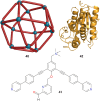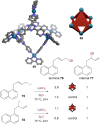Encapsulation of reactive species within metal-organic cages
- PMID: 40747319
- PMCID: PMC12308918
- DOI: 10.1039/d5sc02081f
Encapsulation of reactive species within metal-organic cages
Abstract
Reactivity under confinement often differs greatly from reactivity in the bulk. Metal-organic cages (MOCs) are a class of discrete, solution-processable container molecules encompassing well-defined nanospaces, which can be rapidly constructed in modular fashion via self-assembly. Supramolecular chemists have created an extensive library of MOCs and demonstrated their ability to serve as molecular flasks, with cavities tailored to bind guests of interest. In this review, we cover selected examples of the encapsulation and relative stabilisation of reactive species within MOCs, from early reports to the most recent developments. Most reactive species are not inherently unstable; but they persist only as long as they do not encounter a partner with whom they can react. MOCs can prevent or reduce the rate of this deleterious reactivity through acting as a shield and providing a physical barrier between an encapsulated reactive guest and other system components regularly encountered in the bulk environment, including air, water, solvent, light, another molecule of itself, or a co-reactant. Thus, MOCs can extend the lifetime of these short-lived reactive species enhancing their study, or allowing for different reactivity to be explored. Examples have been segregated based on the nature of stabilisation (i.e., with what partner a reaction has been prevented). We believe this analysis will help provide more nuanced understanding of what types of highly reactive species can be tolerated within a dynamic MOC system to enable MOCs to find use in a wider variety of real-world applications.
This journal is © The Royal Society of Chemistry.
Conflict of interest statement
There are no conflicts to declare.
Figures


























Similar articles
-
Short-Term Memory Impairment.2024 Jun 8. In: StatPearls [Internet]. Treasure Island (FL): StatPearls Publishing; 2025 Jan–. 2024 Jun 8. In: StatPearls [Internet]. Treasure Island (FL): StatPearls Publishing; 2025 Jan–. PMID: 31424720 Free Books & Documents.
-
The Black Book of Psychotropic Dosing and Monitoring.Psychopharmacol Bull. 2024 Jul 8;54(3):8-59. Psychopharmacol Bull. 2024. PMID: 38993656 Free PMC article. Review.
-
Sexual Harassment and Prevention Training.2024 Mar 29. In: StatPearls [Internet]. Treasure Island (FL): StatPearls Publishing; 2025 Jan–. 2024 Mar 29. In: StatPearls [Internet]. Treasure Island (FL): StatPearls Publishing; 2025 Jan–. PMID: 36508513 Free Books & Documents.
-
"In a State of Flow": A Qualitative Examination of Autistic Adults' Phenomenological Experiences of Task Immersion.Autism Adulthood. 2024 Sep 16;6(3):362-373. doi: 10.1089/aut.2023.0032. eCollection 2024 Sep. Autism Adulthood. 2024. PMID: 39371355
-
The Lived Experience of Autistic Adults in Employment: A Systematic Search and Synthesis.Autism Adulthood. 2024 Dec 2;6(4):495-509. doi: 10.1089/aut.2022.0114. eCollection 2024 Dec. Autism Adulthood. 2024. PMID: 40018061 Review.
Cited by
-
Fluorinated Twists: A Pathway to a Stable Pd8L16 Square Antiprism.J Am Chem Soc. 2025 Aug 8;147(33):30296-303. doi: 10.1021/jacs.5c09573. Online ahead of print. J Am Chem Soc. 2025. PMID: 40778826 Free PMC article.
References
-
- Breiner B. Clegg J. K. Nitschke J. R. Reactivity modulation in container molecules. Chem. Sci. 2011;2:51–56. doi: 10.1039/C0SC00329H. - DOI
- Cook T. R. Stang P. J. Recent Developments in the Preparation and Chemistry of Metallacycles and Metallacages via Coordination. Chem. Rev. 2015;115:7001–7045. doi: 10.1021/cr5005666. - DOI - PubMed
- Saha S. Regeni I. Clever G. H. Structure relationships between bis-monodentate ligands and coordination driven self-assemblies. Coord. Chem. Rev. 2018;374:1–14. doi: 10.1016/j.ccr.2018.06.010. - DOI
- Pan M. Wu K. Zhang J.-H. Su C.-Y. Chiral metal–organic cages/containers (MOCs): From structural and stereochemical design to applications. Coord. Chem. Rev. 2019;378:333–349. doi: 10.1016/j.ccr.2017.10.031. - DOI
- Sun Y. Chen C. Stang P. J. Soft Materials with Diverse Suprastructures via the Self-Assembly of Metal–Organic Complexes. Acc. Chem. Res. 2019;52:802–817. doi: 10.1021/acs.accounts.8b00663. - DOI - PMC - PubMed
- Pilgrim B. S. Champness N. R. Metal-Organic Frameworks and Metal-Organic Cages – A Perspective. ChemPlusChem. 2020;85:1842–1856. doi: 10.1002/cplu.202000408. - DOI - PubMed
- Lewis J. E. M. Molecular engineering of confined space in metal–organic cages. Chem. Commun. 2022;58:13873–13886. doi: 10.1039/D2CC05560K. - DOI - PubMed
- Tarzia A. Jelfs K. E. Unlocking the computational design of metal–organic cages. Chem. Commun. 2022;58:3717–3730. doi: 10.1039/D2CC00532H. - DOI - PMC - PubMed
- Tateishi T. Yoshimura M. Tokuda S. Matsuda F. Fujita D. Furukawa S. Coordination/metal–organic cages inside out. Coord. Chem. Rev. 2022;467:214612. doi: 10.1016/j.ccr.2022.214612. - DOI
- Cox C. J. T. Hale J. Molinska P. Lewis J. E. M. Supramolecular and molecular capsules, cages and containers. Chem. Soc. Rev. 2024;53:10380–10408. doi: 10.1039/D4CS00761A. - DOI - PubMed
-
- Yoshizawa M. Klosterman J. K. Fujita M. Functional Molecular Flasks: New Properties and Reactions within Discrete, Self-Assembled Hosts. Angew. Chem., Int. Ed. 2009;48:3418–3438. doi: 10.1002/anie.200805340. - DOI - PubMed
- Smulders M. M. J. Zarra S. Nitschke J. R. Quantitative Understanding of Guest Binding Enables the Design of Complex Host–Guest Behavior. J. Am. Chem. Soc. 2013;135:7039–7046. doi: 10.1021/ja402084x. - DOI - PubMed
- Löffler S. Lübben J. Krause L. Stalke D. Dittrich B. Clever G. H. Triggered Exchange of Anionic for Neutral Guests inside a Cationic Coordination Cage. J. Am. Chem. Soc. 2015;137:1060–1063. doi: 10.1021/ja5130379. - DOI - PubMed
- August D. P. Nichol G. S. Lusby P. J. Maximizing Coordination Capsule–Guest Polar Interactions in Apolar Solvents Reveals Significant Binding. Angew. Chem., Int. Ed. 2016;55:15022–15026. doi: 10.1002/anie.201608229. - DOI - PubMed
- Rizzuto F. J. von Krbek L. K. S. Nitschke J. R. Strategies for binding multiple guests in metal–organic cages. Nat. Rev. Chem. 2019;3:204–222. doi: 10.1038/s41570-019-0085-3. - DOI
- Grommet A. B. Feller M. Klajn R. Chemical reactivity under nanoconfinement. Nat. Nanotechnol. 2020;15:256–271. doi: 10.1038/s41565-020-0652-2. - DOI - PubMed
- Percástegui E. G. Guest-Induced Transformations in Metal-Organic Cages. Eur. J. Inorg. Chem. 2021;2021:4425–4438. doi: 10.1002/ejic.202100657. - DOI
- Lewis J. E. M. Developing sophisticated microenvironments in metal-organic cages. Trends Chem. 2023;5:717–719. doi: 10.1016/j.trechm.2023.06.003. - DOI
- Speakman N. M. A. Heard A. W. Nitschke J. R. A CuI6L4 Cage Dynamically Reconfigures to Form Suit[4]anes and Selectively Bind Fluorinated Steroids. J. Am. Chem. Soc. 2024;146:10234–10239. doi: 10.1021/jacs.4c00257. - DOI - PMC - PubMed
-
- Olenyuk B. Whiteford J. A. Fechtenkötter A. Stang P. J. Self-assembly of nanoscale cuboctahedra by coordination chemistry. Nature. 1999;398:796–799. doi: 10.1038/19740. - DOI - PubMed
- Takeda N. Umemoto K. Yamaguchi K. Fujita M. A nanometre-sized hexahedral coordination capsule assembled from 24 components. Nature. 1999;398:794–796. doi: 10.1038/19734. - DOI
- Debata N. B. Tripathy D. Chand D. K. Self-assembled coordination complexes from various palladium(II) components and bidentate or polydentate ligands. Coord. Chem. Rev. 2012;256:1831–1945. doi: 10.1016/j.ccr.2012.04.001. - DOI
- Tsujimoto Y. Kojima T. Hiraoka S. Rate-determining step in the self-assembly process of supramolecular coordination capsules. Chem. Sci. 2014;5:4167–4172. doi: 10.1039/C4SC01652A. - DOI
- Kieffer M. Pilgrim B. S. Ronson T. K. Roberts D. A. Aleksanyan M. Nitschke J. R. Perfluorinated Ligands Induce Meridional Metal Stereochemistry to Generate M8L12, M10L15, and M12L18 Prisms. J. Am. Chem. Soc. 2016;138:6813–6821. doi: 10.1021/jacs.6b02445. - DOI - PubMed
- Bhattacharyya S. Ali S. R. Venkateswarulu M. Howlader P. Zangrando E. De M. Mukherjee P. S. Self-Assembled Pd12 Coordination Cage as Photoregulated Oxidase-Like Nanozyme. J. Am. Chem. Soc. 2020;142:18981–18989. doi: 10.1021/jacs.0c09567. - DOI - PubMed
-
- Seidel S. R. Stang P. J. High-Symmetry Coordination Cages via Self-Assembly. Acc. Chem. Res. 2002;35:972–983. doi: 10.1021/ar010142d. - DOI - PubMed
- Chakrabarty R. Mukherjee P. S. Stang P. J. Supramolecular Coordination: Self-Assembly of Finite Two- and Three-Dimensional Ensembles. Chem. Rev. 2011;111:6810–6918. doi: 10.1021/cr200077m. - DOI - PMC - PubMed
- Smulders M. M. J. Jiménez A. Nitschke J. R. Integrative Self-Sorting Synthesis of a Fe8Pt6L24 Cubic Cage. Angew. Chem., Int. Ed. 2012;51:6681–6685. doi: 10.1002/anie.201202050. - DOI - PubMed
- Ramsay W. J. Szczypiński F. T. Weissman H. Ronson T. K. Smulders M. M. J. Rybtchinski B. Nitschke J. R. Designed Enclosure Enables Guest Binding Within the 4200 Å3 Cavity of a Self-Assembled Cube. Angew. Chem., Int. Ed. 2015;54:5636–5640. doi: 10.1002/anie.201501892. - DOI - PubMed
- Howlader P. Das P. Zangrando E. Mukherjee P. S. Urea-Functionalized Self-Assembled Molecular Prism for Heterogeneous Catalysis in Water. J. Am. Chem. Soc. 2016;138:1668–1676. doi: 10.1021/jacs.5b12237. - DOI - PubMed
- Oldacre A. N. Friedman A. E. Cook T. R. A Self-Assembled Cofacial Cobalt Porphyrin Prism for Oxygen Reduction Catalysis. J. Am. Chem. Soc. 2017;139:1424–1427. doi: 10.1021/jacs.6b12404. - DOI - PubMed
- Wu Z. Zhou K. Ivanov A. V. Yusobov M. Verpoort F. The simplest and fascinating metal–organic polyhedra: Tetrahedra. Coord. Chem. Rev. 2017;353:180–200. doi: 10.1016/j.ccr.2017.10.008. - DOI
- Komine S. Takahashi S. Kojima T. Sato H. Hiraoka S. Self-Assembly Processes of Octahedron-Shaped Pd6L4 Cages. J. Am. Chem. Soc. 2019;141:3178–3186. doi: 10.1021/jacs.8b12890. - DOI - PubMed
- Tang J.-H. Ni R. He Y.-Q. Vanderlinden R. T. Li Y. Shi B. Li Z.-Y. Wang H. Li X. Sun Y. Zhong Y.-W. Stang P. J. Metal–Organic Pt(II) Hexagonal-Prism Macrocycles and Their Photophysical Properties. Inorg. Chem. 2019;58:13376–13381. doi: 10.1021/acs.inorgchem.9b02267. - DOI - PMC - PubMed
- Black M. R. Bhattacharyya S. Argent S. P. Pilgrim B. S. Structural Transformations of Metal–Organic Cages through Tetrazine-Alkene Reactivity. J. Am. Chem. Soc. 2024;146:28233–28241. - PMC - PubMed
-
- Tominaga M. Suzuki K. Kawano M. Kusukawa T. Ozeki T. Sakamoto S. Yamaguchi K. Fujita M. Finite, Spherical Coordination Networks that Self-Organize from 36 Small Components. Angew. Chem., Int. Ed. 2004;43:5621–5625. doi: 10.1002/anie.200461422. - DOI - PubMed
- Preston D. Inglis A. R. Garden A. L. Kruger P. E. A symmetry interaction approach to [M2L2]4+ metallocycles and their self-catenation. Chem. Commun. 2019;55:13271–13274. doi: 10.1039/C9CC07130J. - DOI - PubMed
Publication types
LinkOut - more resources
Full Text Sources

